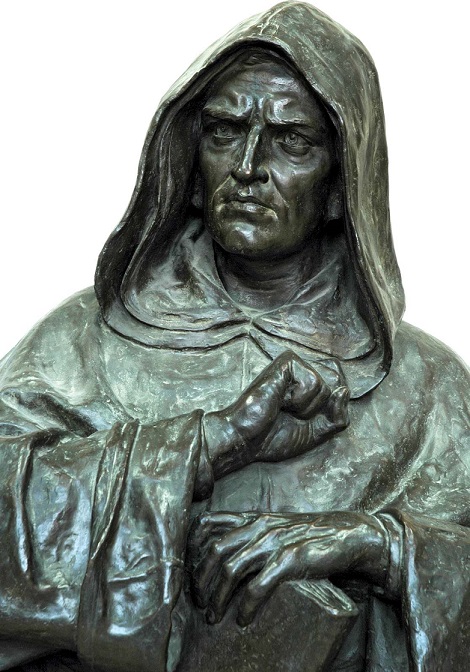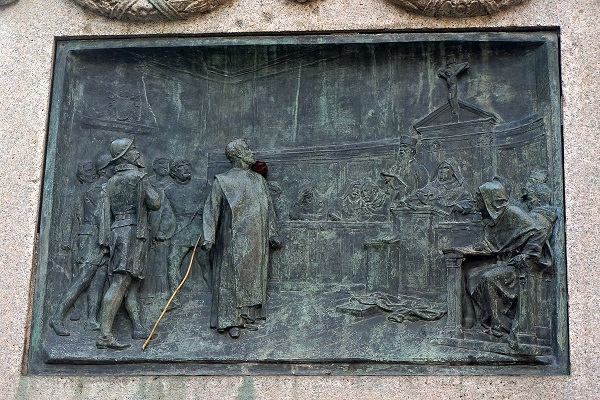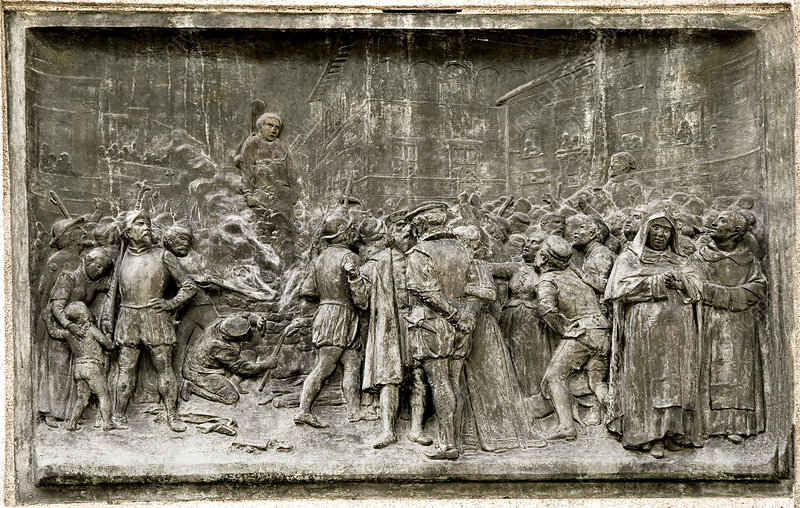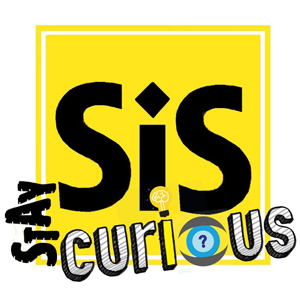
Giordano Bruno was born in Naples, in 1548. His parents, Furless Avrlino and Giovanni Brunno, named him Filipo Bruno. The baby boy grew up influenced by Thomas Aquinas, Everroes, John dun Scores, Marcello Ficino, Plato, Copernicus, Nicolas of Cusco, Raymond, Lully, platonism, Renaissance, etc. Bruno, was labelled in history as a priest, philosopher, writer, mathematician, occultist , martyr and heretic. Around the age of 11, Bruno was taken to Naples for his education. There he attended public lectures at the stadium general and proceeded private lessons at the Augustinian Monastery. By the time he turned 15, he became a part of the Dominican Order at Son Dominica in a monastery. Bruno then decided to change his name to Giordano after Giordano Crispo, his metaphysics teacher. When he turn 24 in 1572,he was ordained as a priest and was becoming well known for his memory. His art of memory became so renowned that he even travelled to Rome to show Pope Pius V his manama system. Bruno’s propensity for freethinking, outspoken criticism of theological doctrines and penchant for both reading and suggesting forbidden books gained him a reputation within the church. Beyond all this, we know little about Bruno’s early life except the clash with his superiors with controversial doctrines in 1576. The conflict made Bruno leave the monastery in favour of a life dedicated to travelling. He was highly influenced by Renaissance ideas such as Platonism, Hermeticism, Epicurionism. The main points of Bruno’s world view were: *The universe is infinite and is interconnected. *the connections are hidden to the human eye. *the connections can only be understood through analogies and motives. Well, this way of understanding of the world would likely seem odd to modern viewers. It was a common aspect in how most Renaissance thinkers viewed reality. For a Renaissance man like Bruno: ‘the world is not a lightless machine but full of spiritual connections that are viewed with hidden meaning of messages’. A good example of a Renaissance thinker can be considered in the Sun and sunflowers. People observe that sun and sunflowers quite look similar. This similarity made many Renaissance thinkers believe: ‘there is existence of hidden spiritual connections between the sun and the sunflowe which is not visible to human eyes’. More to add Renaissance thinkers noticed that: “some flowers looked a bit like the mane of a lion. By this type of analogy they made an equation like: *Lion is symbolised as the source of bravery-bravery is associated from the human heart.

Lateral plaque: Giordano Bruno’s trial for heresy by the Roman Inquisition, Campo de’ Fiori, Rome
By this analogy connections several prominent Renaissance thinkers speculated that, the sunflower can play a good role in medicine in case of heart diseases. By modern views, this type of Renaissance view could seem to be nonsense to many. But, including Giordano Bruno, it was a common analogy and motive of Renaissance. He was the follower of philosophical reasoning that only focuses on images and symbols. He rejected the use of mathematics to explore the Universe since he considered it is too limiting. Being influenced by Heliocentrism , he said that the universe is infinite. And the sun is the centre of the universe, not the earth. He also made questionable statements on behalf of religion which made many people, fellows of the Church, as well as inquisitors, furious. They considered him as a magician, insulting him during lectures, chasing him in streets all over the town of Oxford. During the periods when he was in Oxford; he gave a series of lectures; he wanted to make them realise how ignorant and backward they were. In one lecture he got chased with another Renaissance thinker ‘Marsilio Ficino ‘ . That incident later forced him to leave Oxford. After leaving Oxford, he continued to wander in Europe for several years, until he took a decision to go back to Italy. In 1519 he went to Italy and joined there as a teacher in Venicia Aristocrate. After a few months the noble men of Venicia decided to denounce him as a heretic of Dominican inquisition and sent him off to the end of Rome. Before reaching Rome, Bruno decided to teach his ideas to other prisoners who would teach people and inquisitors about Bruno’s ideas. And made them copy them in notebooks. In this book many statements were found alarming by the inquisitors. The process of inquisition ran for nine years. The case against Bruno was contacted by ‘Roberto Belarmino’. Belarmino drew a list of political statements to help Bruno. Bruno avoided the political statements.

Giordano Bruno’s execution
Rather, he wrote to Belarmino a letter to refuse all that, and said, “This statement is not true at all”, and he, by doing so undermined his confession. “This later angered the Belarmino, and he furiously gave him a choice to refuse all his statements for the sake of his life or burn at the stake. Bravely Bruno took the second choice and on February 17 in 1600, he was stuck in a stake and burned alive. His many cosmological and theological statements were found right after several centuries. * It is said that, he is the first martyr of science which is questionable for many reasons. If you want more, we will later make a series about it including Bruno’s works and philosophy. But, it is a fact that he is the first martyr of free thinking. Besides all debates including positive and negative things about Bruno, we cannot forget his great work at cosmology, philosophy, art of memory and mathematics.
Contributed by Nashin Morium




